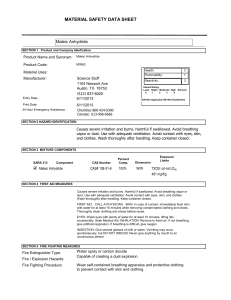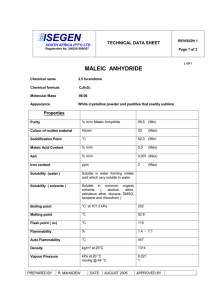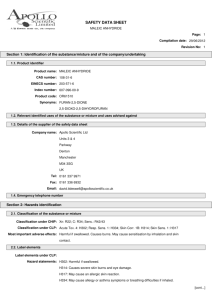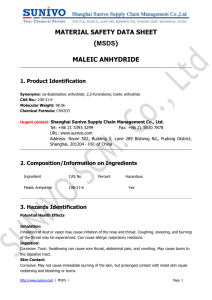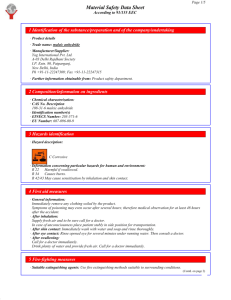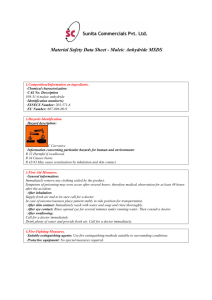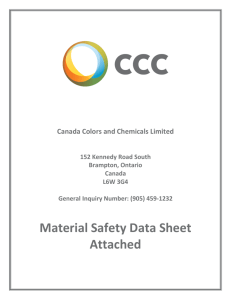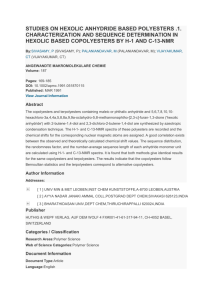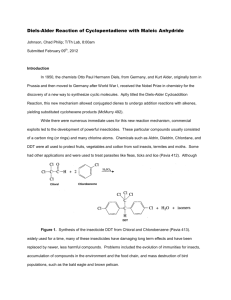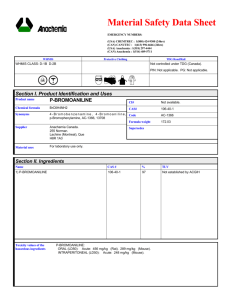8109 MALEIC ANHYDRIDE (English) ANACHEMIA MSDS Canada
advertisement
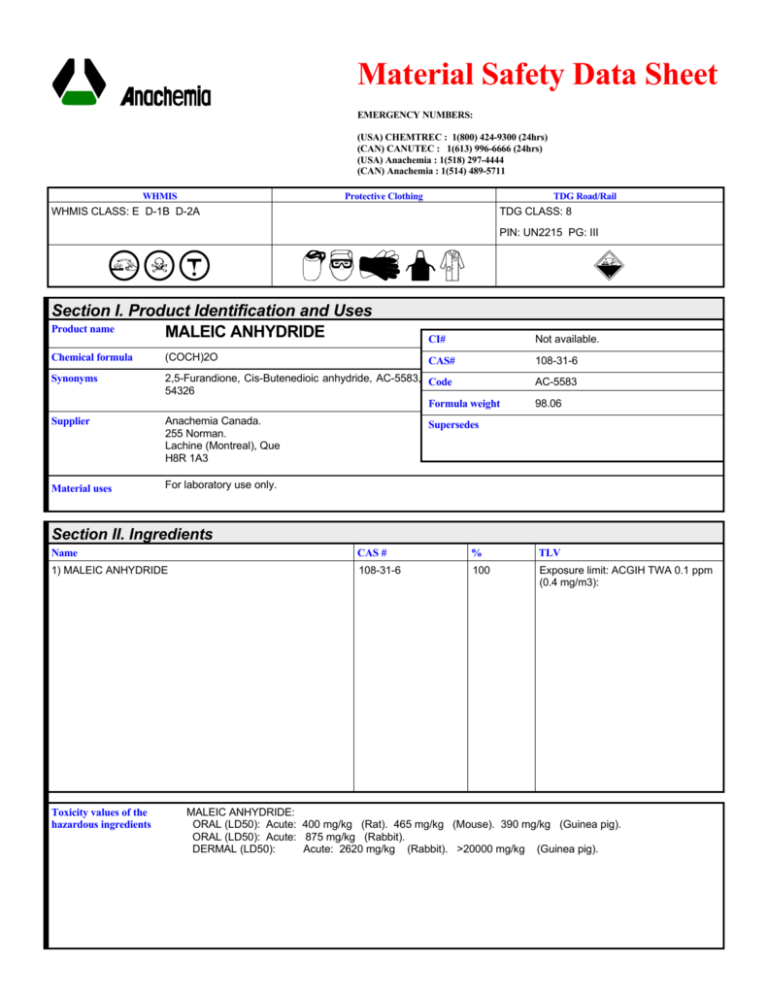
Material Safety Data Sheet EMERGENCY NUMBERS: (USA) CHEMTREC : 1(800) 424-9300 (24hrs) (CAN) CANUTEC : 1(613) 996-6666 (24hrs) (USA) Anachemia : 1(518) 297-4444 (CAN) Anachemia : 1(514) 489-5711 WHMIS Protective Clothing TDG Road/Rail WHMIS CLASS: E D-1B D-2A TDG CLASS: 8 PIN: UN2215 PG: III Section I. Product Identification and Uses Product name MALEIC ANHYDRIDE CI# Not available. CAS# 108-31-6 Chemical formula (COCH)2O Synonyms 2,5-Furandione, Cis-Butenedioic anhydride, AC-5583, Code 54326 Formula weight Supplier Anachemia Canada. 255 Norman. Lachine (Montreal), Que H8R 1A3 Material uses For laboratory use only. AC-5583 98.06 Supersedes Section II. Ingredients Name CAS # % TLV 1) MALEIC ANHYDRIDE 108-31-6 100 Exposure limit: ACGIH TWA 0.1 ppm (0.4 mg/m3): Toxicity values of the hazardous ingredients MALEIC ANHYDRIDE: ORAL (LD50): Acute: 400 mg/kg (Rat). 465 mg/kg (Mouse). 390 mg/kg (Guinea pig). ORAL (LD50): Acute: 875 mg/kg (Rabbit). DERMAL (LD50): Acute: 2620 mg/kg (Rabbit). >20000 mg/kg (Guinea pig). Section III. Physical Data MALEIC ANHYDRIDE Physical state and appearance / Odor pH (1% soln/water) Colorless crystalline needles or white lumps or pellets. Sharp, acrid irritating odor. Odor threshold 1.84 mg/m3 - 1.96 mg/m3 Percent volatile Not available. Freezing point 53°C to 55°C Boiling point 202°C Specific gravity 1.48 (Water = 1) Vapor density 3.38 (Air = 1) Vapor pressure 0.16 (60) mm Hg @ 20°C (122°C) Water/oil dist. coeff. Not available. Evaporation rate Not available. Solubility Readily hydrolyzed in water. page 2/4 Not available. Section IV. Fire and Explosion Data Flash point CLOSED CUP: 102°C (Pensky-Martens.) Flammable limits LOWER: 1.4% UPPER: 7.1% Auto-ignition temperature 476°C Fire degradation products Oxides of carbon (CO, CO2). Hydrocarbons. Fire extinguishing procedures Use carbon dioxide, foam or water spray. DO NOT use dry chemical powder. Water or foam may cause frothing. Wear adequate personal protection to prevent contact with material or its combustion products. Self contained breathing apparatus with a full facepiece operated in a pressure demand or other positive pressure mode. Fire and Explosion Hazards Combustible solid. This material in powder form is capable of creating a dust explosion. Dry chemical extinguishing agents can react with maleic anhydride to produce large volumes of gases that could rupture equipment not properly vented. Eliminate ignition sources and prevent build-up of static electrical charges. Ground all equipment. Yields flammable vapors on heating above melting point. When heated to decomposition it emits acrid smoke and fumes. Section V. Toxicological Properties Routes of entry Inhalation and ingestion. Skin contact. Eye contact. Skin absorption. Effects of Acute Exposure Harmful by ingestion, inhalation or skin absorption. Corrosive. May be fatal. Exposure to concentrations as low as 0.4 mg/m3 has been reported to produce eye and upper respiratory tract irritation. Target organs: eyes, skin, respiratory system. 10 mg/m3 (MALEIC ANHYDRIDE) is immediately dangerous to life or health. Eye Skin Causes severe burns and loss of vision. May cause double vision and photophobia. May cause permanent damage. Vapor can cause a visual disturbance commonly known as "Halo vision". EYE IRRITATION (RABBIT, 24Hr): (FHSA) CORROSIVE. Causes severe burns. Causes burns which may be delayed. Readily absorbed through skin. Repeated contact with this material may cause dermatitis, ulceration and allergic skin reaction. Inhalation Material is extremely destructive to tissue of the mucous membranes and upper respiratory tract. Headache, nausea, vomiting, sneezing, coughing, nosebleed, intense burning sensation in the throat, chronic bronchitis, chemical pneumonitis and pulmonary edema which may have a delayed onset. Attention! Repeated or prolonged inhalation may cause allergic respiratory reaction in some people. Ingestion Burns in mouth, pharynx and gastrointestinal tract. May cause nausea, vomiting, abdominal pain. Section V. Toxicological Properties Effects of Chronic Overexposure MALEIC ANHYDRIDE page 3/4 Repeated exposure of workers to high concentrations have been reported to cause ulceration of the nasal mucous membranes. May cause dermatitis, pulmonary oedema, allergic skin and respiratory reaction (chronic asthma, bronchitis). Effects may be delayed. Carcinogenic effects: Not available. Mutagenic effects: Not available. Teratogenic effects: Foetotoxic in animal. Toxicity of the product to the reproductive system: Not available. To the best of our knowledge the chronic toxicity of this substance has not been fully investigated. Section VI. First Aid Measures Eye contact IMMEDIATELY flush eyes with copious quantities of water for at least 15 minutes holding lids apart to ensure flushing of the entire surface. Seek immediate medical attention. Skin contact Immediately flush skin with plenty of water for at least 15 minutes while removing contaminated clothing and shoes. Call a physician. Wash contaminated clothing before reusing. Discard contaminated leather articles such as shoes and belt. If material is hot, treat for thermal burns and take the victim to hospital immediately. Inhalation Remove patient to fresh air. Administer approved oxygen supply if breathing is difficult. Administer artificial respiration or CPR if breathing has ceased. Seek immediate medical attention. Ingestion Seek immediate medical attention. Section VII. Reactivity Data Stability Unstable. Moisture sensitive! Conditions to avoid: High temperatures, sparks, open flames and all other sources of ignition, contamination. Hazardous decomp. products Maleic acid. Incompatibility Alkali metal ions and amines. At temperatures above 150°C, these materials (at concentrations as low as 200 ppm) can trigger a rapid decomposition and polymerization reaction which will produce heat and gas and may cause equipment to rupture. Water, calcium hydroxide, ammonium salts, dimethylamine, trimethylamine, alcohols, olefins, sodium 2-benzothiazolethiolate, 1-methylsilacyclopenta-2,4-diene, oxidizing agents, acids, bases, pyridine, reducing agents. Reaction Products Maleic anhydride reacts with water or moist air to form maleic acid and heat. Will not self-polymerize but can undergo uncontrolled co-polymerization in presence of other monomers and catalysts. Section VIII. Preventive Measures MALEIC ANHYDRIDE page 4/4 Protective Clothing in Wear self-contained breathing apparatus, rubber boots and heavy rubber gloves. Wear disposable coveralls and case of spill and leak discard them after use. Spill and leak Evacuate the area. Eliminate all sources of ignition. Allow product to solidify if molten. Sweep up and place in container for disposal. Avoid raising dust. Ventilate area and wash spill site after material pick up is complete. DO NOT empty into drains. DO NOT touch damaged container or spilled material. Waste disposal According to all applicable regulations. Harmful to aquatic life at low concentrations. Can be dangerous if allowed to enter drinking water intakes. Do not contaminate domestic or irrigation water supplies, lakes, streams, ponds, or rivers. Storage and Handling Store in a cool place away from heated areas, sparks, and flame. Store in a well ventilated area. Store away from incompatible materials. Do not add any other material to the container. Do not wash down the drain. Do not breathe dust. Keep container tightly closed and dry. Protect from moisture. Manipulate under an adequate fume hood. Avoid raising dust. Take precautionary measures against static discharges. Ground the container while dispensing. Use explosion proof equipment. Use non-sparking tools. Empty containers may contain a hazardous residue. Handle and open container with care. Minimize dust generation and exposure - use dust mask or appropriate protection. Take off immediately all contaminated clothing. This product must be manipulated by qualified personnel. Do not get in eyes, on skin, or on clothing. Wash well after use. In accordance with good storage and handling practices. Do not allow smoking and food consumption while handling. Molten product should be stored under 70°C. Never use welding or cutting torch on or near drum (even empty) because product (even just residue) can ignite explosively. Section IX. Protective Measures Protective clothing Face shield and splash goggles. Impervious gloves, apron, coveralls, and/or other resistant protective clothing. Sufficient to protect skin. A OSHA/MSHA jointly approved respirator is advised in the absence of proper environmental controls. If more than TLV, do not breathe vapor. Wear self-contained breathing apparatus. If mist and/or hot vapors are present, use air-purifying respiratory or self-contained breathing apparatus as required. If handling hot material, use insulated protective clothing (boots, gloves, apron, etc..). Do not wear contact lenses. Make eye bath and emergency shower available. Ensure that eyewash station and safety shower is proximal to the work-station location. Engineering controls Use in a chemical fume hood to keep airborne levels below recommended exposure limits. Use explosion-proof ventilation equipment. Do not use in unventilated spaces. Section X. Other Information Special Precautions or Corrosive! Toxic! Sensitizer! Causes severe burns which may be delayed! Harmful if comments absorbed through skin. May cause allergic skin and respiratory reaction. Hot melted material causes thermal burns to eyes and skin. Do not breathe dust or vapor. Do not get in eyes, on skin, or clothing. Avoid prolonged or repeated exposure. Use in a chemical fume hood. Keep away from heat, sparks and flame. Moisture sensitive! Handle and open container with care. Container should be opened only by a technically qualified person. Can undergo uncontrolled co-polymerization in presence of other monomers and catalysts. Molten product should be stored under 70°C. RTECS NO: ON3675000 (Maleic anhydride). 1 3 1 NFPA Prepared by MSDS Department/Département de F.S.. Validated 23-Nov-2012 Telephone# (514) 489-5711 While the company believes the data set forth herein are accurate as of the date hereof, the company makes no warranty with respect thereto and expressly disclaims all liability for reliance thereon. Such data are offered solely for your consideration, investigation and verification.
